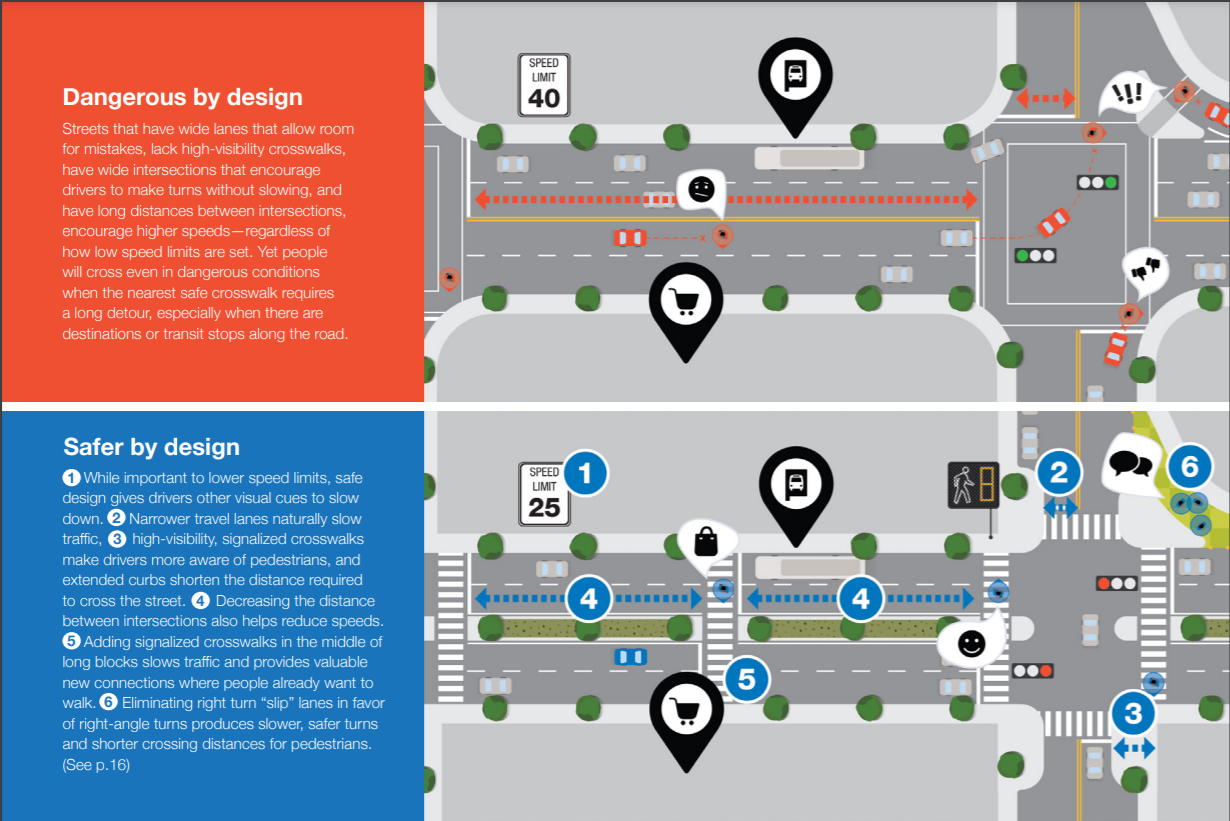Earlier this month Smart Growth America (SGA) released the latest version of their Dangerous by Design series, a biannual report documenting walking conditions in states and metros across the country. Although the report is updated every other year, the findings remain the same: roadways everywhere in the nation pose a mortal threat to pedestrians. The number of pedestrian fatalities continues to climb year after year, with fatalities up 45% from 2010 to 2019. Over the same time period, drivers struck and killed 53,435 people while walking throughout the United States, more than 14 people per day on average.
To compare safety in states and metros across the country, SGA calculates a Pedestrian Danger Index (PDI), which measures the number of people struck and killed while walking, controlling for population size and walking rates. The previous edition of Dangerous by Design ranked Ohio as the 26th most dangerous state for people walking. In this latest edition, Ohio’s ranking improved slightly, dropping to the 27th most dangerous state, but this is only because pedestrian deaths worsened in 49 out of 50 states. Despite improving its danger ranking, the PDI score for the state increased from 39.6 to 44.1 since the last publication.
Vehicle travel speed and vehicle type (the size of the car) are two major elements that determine how deadly an interaction between a pedestrian and a vehicle will be. Other factors then, like lane width, the presence and quality of sidewalks, visible or signalized crosswalks, lighting, and the number of intersections, contribute to the relative danger that a pedestrian will face when walking.
Dangerous by Design relies on state pedestrian crash data, which is processed and released by the federal government. This data has only been released through 2019, meaning that there is no nationwide, pedestrian-specific data for 2020, a year which saw a 13% decrease in driving overall. However, data from the National Safety Council indicates that the year 2020 saw a 24% spike in all traffic fatality rates. Testimony given by ODOT Director Jack Marchbanks reported similar trends in the State of Ohio; while overall traffic volumes in Ohio were down 15% in 2020, traffic deaths rose 7%. According to Director Marchbanks, traffic deaths in Ohio have risen in six of the past seven years despite safer vehicle technology. As roadways emptied out last year, they became significantly deadlier, supporting SGA’s claim that roadway design is the primary cause of traffic fatalities, not driver error (a recent study out of the University of Wisconsin reached the same conclusion).
It’s also impossible to ignore the inequities surrounding pedestrian fatalities. SGA has consistently found throughout all its publications of Dangerous by Design that people of color, especially Black or African American and American Indian or Alaska Native people, continue to die while walking at higher rates compared to White, Non-Hispanic, Asian, and Pacific Islander people. Older adults (people between the ages of 50 and 65, and people over 75) and people walking in low income communities, are also overrepresented in crash deaths. For the first time in the 2021 edition, SGA also found that the systems contributing to pedestrian deaths are as prevalent in rural communities as they are in urban settings; there were 1.7 pedestrian deaths for every 100,000 people in rural areas versus 1.6 pedestrian deaths for every 100,000 people in urban areas.
For all of recent history, transportation planning has prioritized reducing congestion and travel times, which has created the epidemic of growing pedestrian deaths. Fixing current conditions will require putting pedestrians, the most vulnerable roadway users, at the center of transportation planning and design. All roadway owner-operators, meaning cities, counties, and states, have to work together in order to create a safe, integrated, and walkable road network. But there are some recent developments that have GOPC feeling optimistic:
Lawmakers at the federal level have re-introduced the Complete Streets Act, which would encourage states to create standards for complete street design and set aside federal funding for their implementation.
The Manual for Uniform Traffic Control Devices (MUTCD) is currently being revised by USDOT. This purportedly neutral document makes several assumptions and value judgements that continue to center driver convenience and make it harder to improve pedestrian safety. If the MUTCD were revised to support walk/rollability, we could see improvements over time in every town and hamlet in America. You can submit comment to USDOT on the MUTCD revisions here.
Vision Zero continues to gain popularity in cities across America. Vision Zero is a strategy to eliminate traffic fatalities and severe injuries among all road users, and there are many organizations that can help communities interested in committing to zero traffic deaths. Learn more at the Vision Zero Network and see recent coverage in Planetizen here.
ODOT is nearing completion of the Walk.Bike.Ohio plan, which will be the first statewide plan to focus on walking and biking policies and programs. Stay tuned to the GOPC website for news on when the final version will be published.
Fixing roadway networks is a Herculean task that intersects with, and is impacted by, community priorities on equity, economic development, and land use. However, the size of the problem should not distract from the issue: pedestrian fatalities are tragic and they are preventable.
For more information, read Dangerous by Design, watch the official webinar recording, and view the presentation slides.



